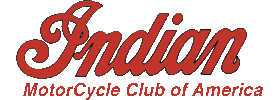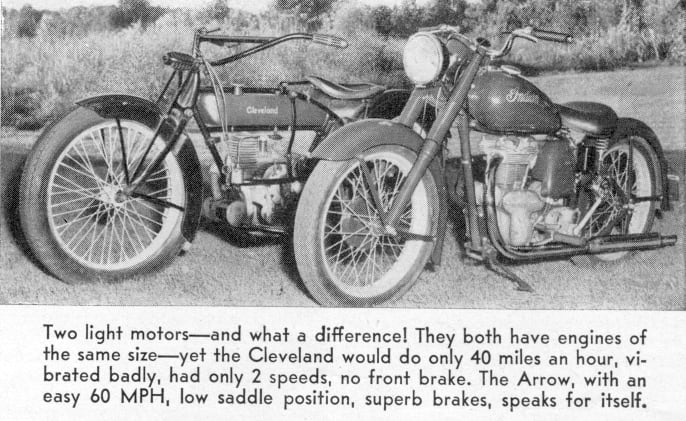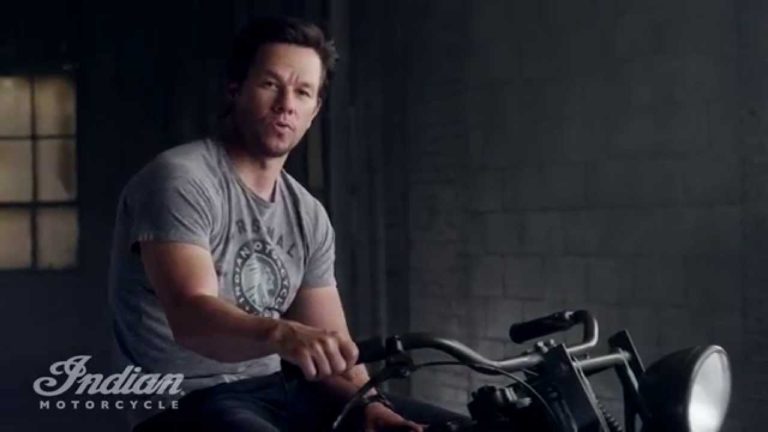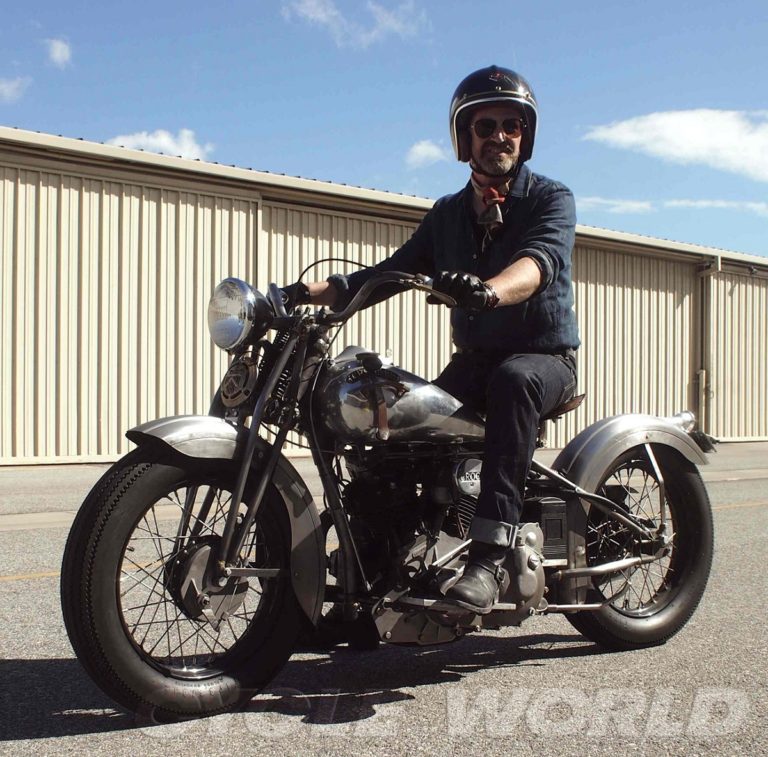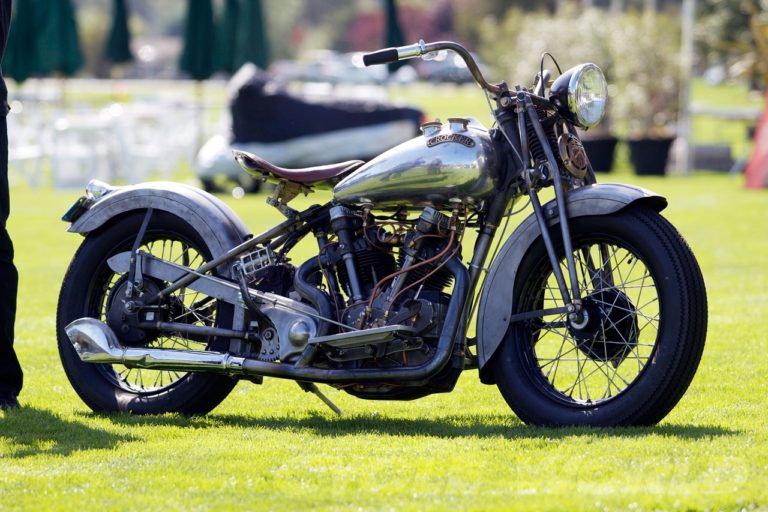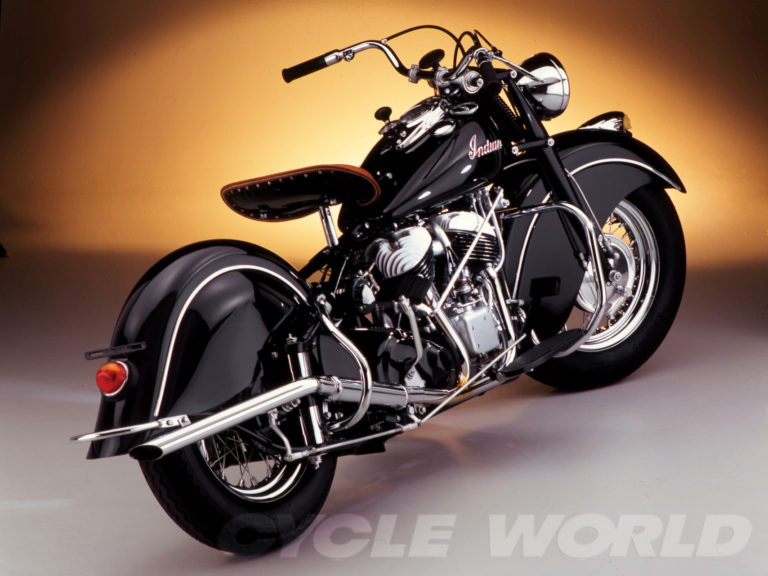By T.A. Hodgdon
SOME FOLKS collect stamps, some go for photography in a big way, others spend all their spare time on the golf course-but my hobby is motorcycling. If I live to be a hundred I will never forget the thrill I had when, at the age of 16, I took delivery of my first brand new motorcycle. It was a Cleveland Lightweight, and it was so beautiful that I could hardly believe it was really mine.
It had fenders and frame finished in lustrous black enamel, gasoline tank and toolbox painted in gleaming blue, and the wheels were painted cream color! It had a small, single cylinder engine, 2 speeds, and a long lever beside the tank, to operate the clutch. The gold letters on the tank spelled out the name “Cleveland,” and I thought they, too, were beautiful. But that was as far as I saw.
My view, at 16 years of age, was limited to what I could see in the gleaming new motorcycle. Little did I realize that you cannot judge a motorcycle from its looks alone. Little did I dream of the vast amount of engineering and testing work which must be done at the factory before a new model is placed on the market.
In the years since that day when the new Cleveland dazzled me with its three-color paint job, I have owned many, many motorcycles of all sizes, makes and types, Some have been good, others excellent, and still others not so good. Why were some better than others? The answer is in the painstaking care put into engineering and testing-before the models were ever placed on the market.

WE ARE TAKEN BEHIND THE SCENES ON THE 4th of July, this year, I was privileged to see, and ride, the new Indian Arrow, the single cylinder overhead valve, four-speed lightweight which is now being bought by riders all over the country, as fast as Indian can turn them off the production line of the new Indian factory. More than that I was privileged to have a full hour’s talk with G. Briggs Weaver, the designer of the Arrow, and William Bandlow, one of the testers who has pounded the new Arrow over thousands of miles of road tests.
In that interview my eyes were opened to many interesting facts which I had not realized-and which I know will be of intense interest to all motorcycle enthusiasts. Here, you may read some of my questions and Mr. Weaver’s answers.
As you read the answers, keep in mind that Mr.. Weaver is probably the smartest motorcycle designer in the world today. He is a former Indianapolis Racing Car designer, was the creator of the Indian Sport Scout which has blazed such a trail of victories in major competitive events over the past 10 years, designer of the Indian Shaft Drive Military motorcycle, and more recently designer of the new Indian Scout Vertical twin.
AT LAST WE LEARN HOW A NEW MOTORCYCLE IS BORN
SITTING in Mr. Weaver’s study, facing him and Bill Bandlow, a test rider, we asked
Q: “How long ago was design work started on this new Indian Arrow which is now sitting out here in the yard ready for me to ride?”
ANS: “We started on it four years ago, after the Management and Sales Department outlined what was wanted. We have worked four years to perfect it-to make absolutely certain, by all known engineering and testing means-that it is by far the best and most serviceable lightweight motorcycle that has ever been produced.

“We know that some motorcycle designs have been produced and released to the public in as little time as a year or two, but we at Indian do not believe in that “rush it through” policy. Time, testing, more engineering, more testing, and consistent, painstaking follow through is the only policy upon which we work. It has to be right in all respects before we O. K. it for production.”
Q: “What was the basic idea … what did you set out to design in the new Arrow Single?”
ANS: “We set out to produce a lightweight motorcycle that would weigh not over 250 lbs.-would be capable of 60 miles per hour top speed, have excellent acceleration, and be extremely durable-able to average road speeds on a trip as good as other road traffic, including larger motorcycles and cars. In short-a lightweight that was tough in ability to take punishment of sustained high speeds-not a `featherweight’ for short trips-but a real serviceable lightweight motorcycle.”

Q: “Do you feel that you have achieved it?”
ANS: “We know that we have.”
Q: “How can you be sure?”
ANS: “Our extensive program of testing, year after year under my close personal observation, each day over those years, has enabled us to eliminate, one after another any minor points which could give trouble, until we have a very sound, reliable motorcycle, which our young, strong, test riders are unable to break down, even when they deliberately set out to “ride it to destruction.”
Q: “How was the road test program conducted?”
ANS: “Well, our 75,000 miles of road testing on this new design were conducted in two stages. We started by designing and constructing two pilot models. These were put on the road three years ago, and sent out on the road in the hands of testers who were ordered to report every 6 or 8 hours, on general handling, characteristics, riding qualities, arrangement of controls, operation of clutch, gearbox, brakes, and all other details in the motorcycle.
“Each item was carefully watched, findings noted, and careful records made. Occasional modifications were made. Each small improvement made the motorcycle better, and prepared it for the day we would start the second stage of road testing.”

Q: “What was the second stage of road testing ?”
ANS: “I will let Bill Bandlow, who did a great deal of that road testing, answer that one.”
BILL, who has been a motorcycle rider for fifteen years, and who was a Flight Instructor in Texas for three years during the war, grinned and said, “When the day came that the models were ready for the acid test, my boss, Clarence Bergsma, head of the Testing Department, told us to take those motorcycles out, pile up the mileage, day after day, seek out the worst roads we could find-pound the daylights out of ’em-in fact, beat ’em up. We did, for weeks on end. Most of us on the testing end had been riding big Chiefs and Sport Scouts, and we had our eyes opened to what a lightweight motorcycle really can do.
“We were told to ride these models just as fast as we could hour after hour, and that is what we did. We soon, changed our ideas-found this new lightweight could maintain almost as high road speeds as even a big Chief with an engine several times as big! Now I don’t mean it’s as fast on the straightaway-but because of its lighter weight and ability to hold the road-it can make wonderful time on the curved and winding roads. I think Mr. Weaver can give you an example of what I mean.”
“Yes,” said Mr. Weaver, “we had a good example a few weeks ago. A young man left Springfield on the Arrow, headed for the Laconia Races. He made the 160 miles in 31/2 hours over exceedingly twisting, tortuous roads, at average speed of close to 45 miles per hour-and you wouldn’t make that trip in a car in any better time than that.”
“Yes,” cut in Bandlow, the tester “-and you probably wouldn’t make it any faster on a big `61′ or `74’you wouldn’t go `boiling’ into those winding roads on a big, heavy machine, as fast as you could on the Arrow, because of the ease of handling on the turns.”
Q: “Mr. Weaver, tell me of a specific instance of a high speed test with the new model.”
ANS: “First of all-our own testers have never been able to break one up-over thousands of miles of speed. We took one of the new models to a place where there is no speed limit-the famous Harrisburg Turnpike, the super speed highway that runs across Pennsylvania. We put a tester on it-told him to turn it on-full speed, and hold it on full throttle for the entire 156 mile run, up long hills and down long hills-a supreme test of any engine. Only in the tunnels did he ease off on the throttle. The new model took the full throttle beating for the 156 miles without a murmur. There wasn’t even an oil leak showing, and she idled like a kitten after 156 miles on wide open throttle!”
Q: “After you were satisfied with the pilot models, what was the next step?”
ANS: “The pilot models were now put aside, and we built several prototypes of production models, that is, we incorporated all the improvements the pilot models had shown necessary. These models were duplicates of the motorcycles later to be put into production. We now started all over again with the heavy road testing program-told the testers to take the prototype models out and beat ’em up -and this continued for months, until we were satisfied the models to be put into production were perfect.”

Q: “Now, gentlemen, how do you account for this extreme durability from a motorcycle of only performance inches piston displacement, and weighing only 250 pounds?”
ANS: “From a durability angle we put only the best of materials and most modern design into the new Arrow-and that goes for the new Vertical Twin Scout as well. For instance the cylinder is of iron, with aluminum alloy finning cast onto the process developed during the war for air cooled engines. A very high percentage of the working parts throughout the whole motorcycle are of highest grade alloy steels-parts which in most motorcycles would be made of less expensive material. We further added strength and saved weight by using die castings wherever possible. We have spared no expense in design, testing, or in tooling, to make the new models extremely durable and reliable no matter how the rider flogs the machine.”
Then Bill Bandlow added, in typical tester’s jargon, “Ted, you can take this Arrow out on the road, crack the whip, dig in the spurs, tuck in your elbows-and roll ‘er up to maximum “revs” for hours at a time and you can’t hurt it.”

MR. WEAVER then continued: “To get excellent acceleration and a good turn of high speed, we have both an engine and transmission that reduce friction to the lowest possible degree. The whole mechanism runs free and easily, largely on ball or roller bearings. Proper lubrication of each bearing has been most carefully worked out. For instance, the connecting rod lower end bearing receives fresh oil under 50 pounds pressure from the instant the engine is started.
“Having thus reduced friction to a minimum, the power output can be utilized for the acceleration and speed the rider wants, rather than in overcoming the friction that is found in less carefully engineered motorcycles. That is a long story-and there is a great deal in it. More could be told about it if we had the space.
“The engine, of 13 cubic inches piston displacement, is of overhead valve design which gives extremely snappy performance. Clutch is cork faced, with eight friction surfaces; the transmission has four speeds, runs on ball and roller bearings; the wheels are on roller and ball bearings. As a result of this expensive construction, we are positive this motorcycle will surpass in performance anything of its size, as well as many motorcycles having considerably more power.”
Q: “All the experienced riders who have ridden the Arrow tell me it holds the road exceptionally well feels very steady-has no bounce or weaving, on any road, at any speed. How did you accomplish this?”
ANS: “I will be frank-we started by designing into the motorcycle all the knowledge of road-holding we have gained in our many years of racing success. While this is no racing motorcycle, it is a well known fact that the race course has been the proving ground for outstanding automotive developments.”
WE TRY THE ARROW ON THE ROAD AFTER thanking Mr. Weaver for his courtesies and for a mighty interesting hour, we started out to ride this- wonderful new motorcycle -our head filled with a new conception of the vast amount of engineering and test work that made it possible.
The road holding is exceptionally good, and we found it hard to believe we were on a lightweight: The engine is a sweet running mechanism that seems to be happy in any of the four gears, even on a wide open throttle in second or third. .
On the model we rode, vibration at any speed is positively not there she is smooth as glass from zero to 63 miles per hour, the top speed we hit. We like the gear ratios, which are 17 to one in low, 11.69 to one in second, 7.4 in third and 6.12 to one in fourth.

EXCELLENT PERFORMANCE AFTER checking the speedometer with one we knew to be right on the button, we made tests in all four speeds-found these results: In low gear, 30 miles per hour. In second gear 41 miles per hour. In third 55, and in fourth, 63 miles per hour, and if we had let ‘er roll a bit farther think she would have touched 65. The new. Indian Arrow is a thoroughbred-worthy of its long line of illustrious ancestors, the product of an excellent modern engineering and test-program, covering four years. THE END
